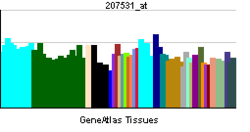CRYGC
| Crystallin, gamma C | |||||||||||||
|---|---|---|---|---|---|---|---|---|---|---|---|---|---|
| |||||||||||||
| Identifiers | |||||||||||||
| Symbols | CRYGC ; CCL; CRYG3; CTRCT2 | ||||||||||||
| External IDs | OMIM: 123680 MGI: 88523 HomoloGene: 36281 GeneCards: CRYGC Gene | ||||||||||||
| |||||||||||||
| RNA expression pattern | |||||||||||||
 | |||||||||||||
| More reference expression data | |||||||||||||
| Orthologs | |||||||||||||
| Species | Human | Mouse | |||||||||||
| Entrez | 1420 | 12966 | |||||||||||
| Ensembl | ENSG00000163254 | ENSMUSG00000025952 | |||||||||||
| UniProt | P07315 | Q61597 | |||||||||||
| RefSeq (mRNA) | NM_020989 | NM_001082573 | |||||||||||
| RefSeq (protein) | NP_066269 | NP_001076042 | |||||||||||
| Location (UCSC) |
Chr 2: 208.13 – 208.13 Mb |
Chr 1: 65.07 – 65.07 Mb | |||||||||||
| PubMed search | |||||||||||||
Crystallin, gamma C, also known as CRYGC, is a protein which in humans is encoded by the CRYGC gene.[1][2]
Function
Crystallins are separated into two classes: taxon-specific, or enzyme, and ubiquitous. The latter class constitutes the major proteins of vertebrate eye lens and maintains the transparency and refractive index of the lens. Since lens central fiber cells lose their nuclei during development, these crystallins are made and then retained throughout life, making them extremely stable proteins. Mammalian lens crystallins are divided into alpha, beta, and gamma families; beta and gamma crystallins are also considered as a superfamily. Alpha and beta families are further divided into acidic and basic groups. Seven protein regions exist in crystallins: four homologous motifs, a connecting peptide, and N- and C-terminal extensions. Gamma-crystallins are a homogeneous group of highly symmetrical, monomeric proteins typically lacking connecting peptides and terminal extensions. They are differentially regulated after early development. Four gamma-crystallin genes (gamma-A through gamma-D) and three pseudogenes (gamma-E, gamma-F, gamma-G) are organized in a genomic segment as a gene cluster. Whether due to aging or mutations in specific genes, gamma-crystallins have been involved in cataract formation.[2]
Interactions
CRYGC has been shown to interact with CRYBB2,[3] CRYAA[3] and CRYAB.[3]
References
- ↑ den Dunnen JT, Moormann RJ, Cremers FP, Schoenmakers JG (1985). "Two human gamma-crystallin genes are linked and riddled with Alu-repeats". Gene 38 (1-3): 197–204. doi:10.1016/0378-1119(85)90218-5. PMID 4065573.
- 1 2 "Entrez Gene: CRYGC crystallin, gamma C".
- 1 2 3 Fu, Ling; Liang Jack J-N (Feb 2002). "Detection of protein-protein interactions among lens crystallins in a mammalian two-hybrid system assay". J. Biol. Chem. (United States) 277 (6): 4255–60. doi:10.1074/jbc.M110027200. ISSN 0021-9258. PMID 11700327.
Further reading
- Graw J (1998). "The crystallins: genes, proteins and diseases.". Biol. Chem. 378 (11): 1331–48. doi:10.1515/bchm.1997.378.11.1299. PMID 9426193.
- Slingsby C, Clout NJ (2000). "Structure of the crystallins.". Eye (London, England). 13. ( Pt 3b): 395–402. doi:10.1038/eye.1999.113. PMID 10627816.
- Hearne CM, Todd JA (1991). "Trinucleotide repeat polymorphism at the CRYG1 locus.". Nucleic Acids Res. 19 (19): 5450. doi:10.1093/nar/19.19.5450-a. PMC 328932. PMID 1923840.
- Brakenhoff RH, Aarts HJ, Reek FH; et al. (1991). "Human gamma-crystallin genes. A gene family on its way to extinction.". J. Mol. Biol. 216 (3): 519–32. doi:10.1016/0022-2836(90)90380-5. PMID 2258929.
- den Dunnen JT, van Neck JW, Cremers FP; et al. (1989). "Nucleotide sequence of the rat gamma-crystallin gene region and comparison with an orthologous human region.". Gene 78 (2): 201–13. doi:10.1016/0378-1119(89)90223-0. PMID 2777080.
- Shiloh Y, Donlon T, Bruns G; et al. (1986). "Assignment of the human gamma-crystallin gene cluster (CRYG) to the long arm of chromosome 2, region q33-36.". Hum. Genet. 73 (1): 17–9. doi:10.1007/BF00292656. PMID 3011643.
- Lubsen NH, Renwick JH, Tsui LC; et al. (1987). "A locus for a human hereditary cataract is closely linked to the gamma-crystallin gene family.". Proc. Natl. Acad. Sci. U.S.A. 84 (2): 489–92. doi:10.1073/pnas.84.2.489. PMC 304234. PMID 3025877.
- Meakin SO, Du RP, Tsui LC, Breitman ML (1987). "Gamma-crystallins of the human eye lens: expression analysis of five members of the gene family.". Mol. Cell. Biol. 7 (8): 2671–9. PMC 367883. PMID 3670288.
- Meakin SO, Breitman ML, Tsui LC (1985). "Structural and evolutionary relationships among five members of the human gamma-crystallin gene family.". Mol. Cell. Biol. 5 (6): 1408–14. PMC 366871. PMID 4033658.
- den Dunnen JT, Moormann RJ, Cremers FP, Schoenmakers JG (1986). "Two human gamma-crystallin genes are linked and riddled with Alu-repeats.". Gene 38 (1-3): 197–204. doi:10.1016/0378-1119(85)90218-5. PMID 4065573.
- Andley UP, Mathur S, Griest TA, Petrash JM (1997). "Cloning, expression, and chaperone-like activity of human alphaA-crystallin.". J. Biol. Chem. 271 (50): 31973–80. doi:10.1074/jbc.271.50.31973. PMID 8943244.
- Lampi KJ, Ma Z, Shih M; et al. (1997). "Sequence analysis of betaA3, betaB3, and betaA4 crystallins completes the identification of the major proteins in young human lens.". J. Biol. Chem. 272 (4): 2268–75. doi:10.1074/jbc.272.4.2268. PMID 8999933.
- Héon E, Priston M, Schorderet DF; et al. (1999). "The gamma-crystallins and human cataracts: a puzzle made clearer.". Am. J. Hum. Genet. 65 (5): 1261–7. doi:10.1086/302619. PMC 1288278. PMID 10521291.
- Ren Z, Li A, Shastry BS; et al. (2000). "A 5-base insertion in the gammaC-crystallin gene is associated with autosomal dominant variable zonular pulverulent cataract.". Hum. Genet. 106 (5): 531–7. doi:10.1007/s004390050021. PMID 10914683.
- Fu L, Liang JJ (2002). "Detection of protein-protein interactions among lens crystallins in a mammalian two-hybrid system assay.". J. Biol. Chem. 277 (6): 4255–60. doi:10.1074/jbc.M110027200. PMID 11700327.
- Fu L, Liang JJ (2002). "Conformational change and destabilization of cataract gammaC-crystallin T5P mutant.". FEBS Lett. 513 (2-3): 213–6. doi:10.1016/S0014-5793(02)02313-X. PMID 11904153.
- Santhiya ST, Shyam Manohar M, Rawlley D; et al. (2002). "Novel mutations in the gamma-crystallin genes cause autosomal dominant congenital cataracts.". J. Med. Genet. 39 (5): 352–8. doi:10.1136/jmg.39.5.352. PMC 1735119. PMID 12011157.
- MacCoss MJ, McDonald WH, Saraf A; et al. (2002). "Shotgun identification of protein modifications from protein complexes and lens tissue.". Proc. Natl. Acad. Sci. U.S.A. 99 (12): 7900–5. doi:10.1073/pnas.122231399. PMC 122992. PMID 12060738.
| ||||||||||||||||||||